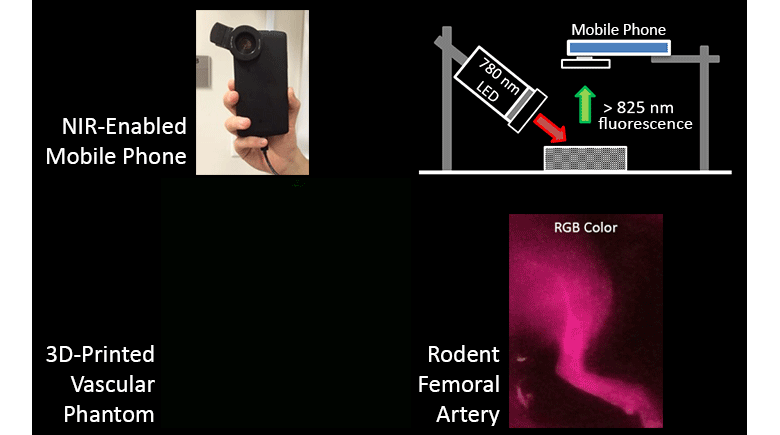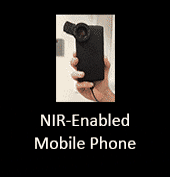
Mobile phone technology represents a novel platform for optical imaging that may have significant advantages for telemedicine, global health, emergency response and military medicine applications. Several clinical optical devices based on mobile phones have been developed, including those performing visible light ophthalmic, otoscopic and cervical imaging. However, while many modern clinical diagnostic devices use near-infrared (NIR) light – such as fluorescence-based vascular imagers – the NIR capability of CMOS-based mobile phone cameras has not yet been exploited. Removing the IR-blocking filter from these cameras may open the door to a wide range of novel devices and applications that improve patient care. Furthermore, there is a need to address the lack of standardized methods for objective image quality testing in emerging mobile and NIR fluorescence imaging technologies; techniques that may facilitate development and clinical translation. The first step towards evaluation of phone camera NIR imaging capability involved characterizing detection sensitivity across the 700-1100 nm range. Subsequently, we used an imaging system based on 780 nm excitation and detection of fluorescence above 825 nm. Images were generated with indocyanine green (ICG) as a contrast agent in an ex vivo rodent model and a 3D-printed tissue-simulating vascular phantom, as well as two types of molded polymer phantoms for image quality assessment. Our results indicated that NIR fluorescence could be visualized in the rodent model at a clinically-relevant ICG concentration. Additionally, the mobile camera showed variations in spectral sensitivity, detection linearity and spatial resolution that were dependent on both image processing and pixel color channel. Overall, we found extensive evidence of the potential for mobile phones to perform NIR fluorescence imaging, although image quality characteristics were generally inferior to a CCD-based system. Additionally, several performance test methods studied showed significant potential for standardizing assessment of NIR fluorescence imagers.
Research website:
https://www.fda.gov/MedicalDevices/ScienceandResearch/ResearchPrograms/ucm477407.htm

